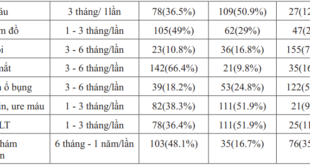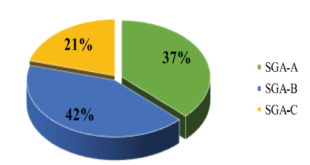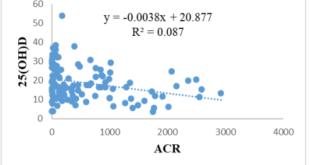SERUM LEPTIN LEVELS AND INSULIN RESISTANCE
IN PRE-DIABETIC PATIENTS
Tran Minh Triet, Diep Thi Thanh Binh, Nguyen Hai Thuy*
University Medical Center at HCM City,* Hue University of Medicine and Pharmacy
ABSTRACT
Aimsof this study was to assess the serum leptin concentrations and insulin resistance, and the relationship between them with other factors in pre-diabetic population. Patients and Methods:A cross sectional study performed on 275pre–diabetic and 116 healthy subjects. Fasting blood samples were assayed for leptin, glucose, HbA1c, insulin, lipid profile and hsCRP concentrations. Results: Serum leptin level was significantly higher in the prediabetes group compare with the control group [4.57 (0.04 – 61.57) vs 3.67(0.04 – 28.94) ng/ml,P < 0.001 ]. The prevalence of hyperleptinemia was 41% and Leptin levels have been found to be correlated with female gender, overweight, viseral obesity, plasma insulin levels, HOMA-IR and plasma levels of hsCRP. The HOMA-IR were significantly higher in prediabetes group than control group [2.1 (0.20 – 12.3) vs 1.3 (0.01 – 6),P < 0.001 ].The prevalence of insulin resistance was 61% of prediabetic patients and the serum leptin level was considered as the independent risk factor of insulin resistance. Conclusions: The serum leptin concentrations and insulin resistance were higher in Prediabetic patients than in normal subjects and leptin level was associated with insulin resistance.
Keywords: serum leptin, pre-diabetes, diabetes, obesity.
Main correspondence:Tran Minh Triet
Submission date: 7 Feb 2017
Revised date: 19 Feb 2017
Acceptance date: 15Mar 2017
I. INTRODUCTION:
The prevalence of type 2 diabetic patient is increasing rapidly in both developed and developing countries and its complications account for the majority of the social and economic burden around the world. Today, many studies focus on the early identification and intervention of diabetes, especially at the stage of pre-diabetes. The prevalence of pre-diabetes, a intermediate hyperglycemic stage between normal and diabetes, is also increasing because of overweight and obesity.
The discovery of leptin in 1994 changed the knowledge of energy homeostasis and our view of adipose tissue from a simple energy depot to an active endocrine organ. Leptin is mainly produced in adipose tissue and plays an important role in regulating energy homeostasis, food intake and energy expenditure. Leptin has been developed as a therapy for some obese people, and for treating the life-threatening metabolic disorder lipodystrophy, other forms of diabetes.
Although leptin has an important role in obesity, its application in clinical practice is controversial because most of obese patients have increased serum leptin concentration, also called “leptin resistance phenomenon”. Many studies have concluded that there was a relationship between leptin and insulin, insulin resistance, and that leptin level can predict future diabetes.
There are currently few studies that investigate the relationship between leptin with other risk factors in prediabetic population , so we carry out this study to evaluate the serum leptin concentration, state of insulin resistance and the relationship between them with other risk factors in pre-diabetic patients.
II. METHODS :
1.Study design: Cross-sectional analysis.
2. Study population:
Patients were diagnosed pre-diabetes according to the criteria of ADA in 2010 (fasting blood glucose: 100-125 mg/dL or HbA1c : 5.7 – 6.4%).
Control group : healthy individuals with normal blood glucose.
3. Laboratory test:
Fasting venous blood samples were collected in the morning and measured: glucose (mg%), insulin (microU/ml), total cholesterol, triglyceride, LDL – c, HDL-c and hsCRP . HOMA – IR was calculated by [Glucose (mmol/L) x Insulin (mUI/L)]/22,5. Insulin resistance was defined as the highest quartile of HOMA – IR in control group (≥1.8 in this study). Serum leptin levels was measured by ELISA method and hyperleptinemia was defined as the highest quartile of leptin level in the control group
(≥ 6.2 ng/mL in this study).
4. Statistical methods: Data were analyzed by STATA 12.0
III. RESULTS :
A cross sectional studyperformed on275pre–diabetesand 116 healthy individuals (control group) showed that.
Table1. Serum leptin levels and HOMA-IR in the study groups
 The median serum of leptin concentration in the prediabetic group was 4.57 (0.04 – 61.57) ng/mL and significantly higher than control group. The prevalence of hyperleptinemia was 41% of prediabetic subjects. The BMI, systolic blood pressure, waist and hip circumference, HbA1c, total cholesterol, LDL-c, hs-CRP, insulin level and HOMA-IR were significantly higher in prediabetic patients than the prediabetic-group with normal serum leptin levels. In the prediabetic females, there were significantly associated between serum leptin concentrations with abdominal obesity, overweight and insulin resistance with the serum leptin levels. And the leptin concentration was correlated to plasma insulin levels and HOMA-IR, in which the correlation coefficient was respectively 0.3268 and 0.2882 (p < 0.0001).
The median serum of leptin concentration in the prediabetic group was 4.57 (0.04 – 61.57) ng/mL and significantly higher than control group. The prevalence of hyperleptinemia was 41% of prediabetic subjects. The BMI, systolic blood pressure, waist and hip circumference, HbA1c, total cholesterol, LDL-c, hs-CRP, insulin level and HOMA-IR were significantly higher in prediabetic patients than the prediabetic-group with normal serum leptin levels. In the prediabetic females, there were significantly associated between serum leptin concentrations with abdominal obesity, overweight and insulin resistance with the serum leptin levels. And the leptin concentration was correlated to plasma insulin levels and HOMA-IR, in which the correlation coefficient was respectively 0.3268 and 0.2882 (p < 0.0001).
Table 1. Characteristics of factors between hyperleptinemia group and normal leptinemia group in pre-diabetic population

Table 2 : Related factors for hyperleptinemia
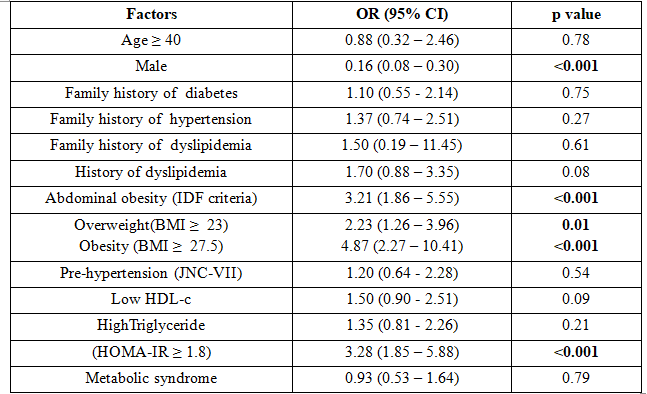
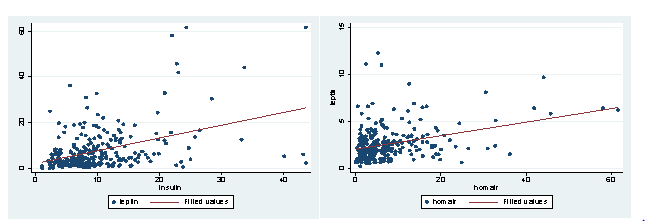
The proportion of insulin resistance in pre-diabetes was 61.5% and associated with age, abdominal obesity, overweight, pre-hypertension, low HDL-c, high triglyceride and hyperleptinemia. In the multiple variables regression analysis model, we found that hyperleptinemia was an independent risk factor of insulin resistance in pre-diabetic patients.
Table 3 : Related factors of insulin resistance in pre-diabetes

IV. DISCUSSIONS :
The median serum leptin concentration in this study was 4.57 (0.04 – 61.57) ng/mL and statistically significantly higher than control group. This result was similar to previous studies. Leptin level was associated with the whole body fat, and might play a role in the pathogenesis of type 2 diabetes. In 1999, J. McNeely noted that baseline leptin levels predicted diabetes independent of baseline total fat, insulin, insulin resistance, glucose, or age in separate multiple logistic regression models after 5 years of follow-up in men[8]. Several years later, Soderberg (2007)[12] and Paul Welsh (2009)[16] also concluded that leptin was an independent predictive factors for diabetes in the future, but only statistically
significant among men. These authorssuggested that the reason was high estrogen
levels, high leptin sensitivity in the brain and lower visceral fat mass in women. Another study has showed that the fasting glucose/leptin ratio can be used in addition to other ratios to accurately assess insulin resistance in subjects with hyperglycemia…[5]. In 2010, Guoying Wang carried out a study on 579 Chinese patients and showed that higher levels of serum leptin increased the risk of pre-diabetes with OR = 4.3 (95% CI: 2.1-8.7) in men and OR = 3.1 ( 95% CI: 1.5-6.2) in women[14]. According to Arleta Malecha – Polish Jedraszek, higher leptin concentrations were revealed in the type 2 diabetes group as compared to the control group, and this figure remained significant after adjusting for gender and age (p < 0.001). However, not all studies have reported increased levels of serum leptin in diabetic patients. A few studies in Asia showed that leptin concentration was lower in diabetic patients, but remained significantly correlated with BMI[1],[2]. The latest study in 2015 on obese adolescents reported lower blood leptin levels in people with type 2 diabetes compared with controls (18 ± 12 vs 37 ± 23 ng/mL, p<0.001), while adiponectin did not differ between the two groups[10].
In our study, leptin concentration was statistically significantly associated with insulin level, HOMA-IR, and increased the risk of insulin resistance in prediabetes independent of BMI and lipid profile. Many studies have concluded that leptin level was directly related to insulin sensitivity independent of body fat mass. Insulin resistance was associated with elevated serum leptin levels independent of body fat mass, even with low BMI[11]. According to Radka Lichnovska, leptin was an important risk factor of insulin resistance[7]. Some other studies indicated a direct correlation between fasting blood leptin and insulin (r=0.598, p=0.05) and HOMAI-IR[3],[9]. In addition, leptin concentration in those with metabolic syndrome were statistically significantly higher than those without metabolic syndrome[6],[13],[15].
In summary, many studies showed a correlation between leptin and diabetes, and elevated serum leptin level could predict future type 2 diabetes. Some studies in Asia showed a lower leptin level in diabetic patients, especially in non-obese diabetes. These results were inconsistent because of the study population, stages of diabetes, time of diagnosis …. as well as different BMI, insulin resistance and leptin measurement method.
However, most of studies have indicated a significant correlation between leptin and insulin, HOMA-IR and leptin increased the risk of insulin resistance independent of BMI and whole body fat. Leptin resistance and the change in leptin concentration might be similar to insulin resistance in diabetes but more studies are needed to confirm this.
V. CONCLUSIONS
In our study, we conclude that serum leptin levels and insulin resistance were statistically significantly higher in pre-diabetes compared with normal subjects. And Leptin was significantly associated with abdominal obesity, overweight and insulin resistance. Leptin could be an independent risk factor of insulin resistance in patients with pre-diabetes.
REFERENCES
- Ahsan Kazmi, K. M. T. (2012). Association of leptin with type 2 diabetes in non-obese subjects. J Ayub Med Coll Abbottabad, 24(3-4), 186-189.
- Al-Shoumer, K. A., Al-Asousi, A. A., Doi, S. A. & Vasanthy, B. A. (2008). Serum leptin and its relationship with metabolic variables in Arabs with type 2 diabetes mellitus. Ann Saudi Med, 28(5), 367-370.
- Almeida-Pititto, B. D., Gimeno, S. G., Sanudo, A., Ribeiro-Filho, F. F., Ferreira, S. R. & Japanese-Brazilian Diabetes Study, G. (2005). Leptin is associated with insulin resistance in Japanese migrants. Metab Syndr Relat Disord, 3(2), 140-146.
- Arleta Malecha-Jedraszek, A. B., Beata Matyjaszek-Matuszek, Helena Donica. (2015). Serum leptin concentration in patients with type 2 diabetes. Curr. Issues Pharm. Med. Sci., , 28(4), 236-241.
- Baban, R. S., Kasar, K. A. K. & Al-Karawi, I. N. (2010). Fasting Glucose to Leptin Ratio as a New Diagnostic Marker in Patients with Diabetes Mellitus. Oman Medical Journal, 25(4), 269-275.
- Esteghamati, A., Khalilzadeh, O., Anvari, M., Rashidi, A., Mokhtari, M. & Nakhjavani, M. (2009). Association of Serum Leptin Levels With Homeostasis Model Assessment–Estimated Insulin Resistance and Metabolic Syndrome: The Key Role of Central Obesity. Metabolic Syndrome and Related Disorders, 7(5), 447-452.
- Lichnovská, R., Gwozdziewiczová, S., Chlup, R. & Hřebíček, J. (2005). Serum leptin in the development of insulin resistance and other disorders in the metabolic syndrome. Biomedical papers, 149(1), 119-126.
- McNeely, M. J., Boyko, E. J., Weigle, D. S., Shofer, J. B., Chessler, S. D., Leonnetti, D. L., et al. (1999). Association between baseline plasma leptin levels and subsequent development of diabetes in Japanese Americans. Diabetes Care, 22(1), 65-70.
- Mohiti J, A. M., Babaei A. (2005). Relation Between Leptin and Insulin In Patients With Type II Diabetes Mellitus. Int J Endocrinol Metab, 3, 121-125.
- Reinehr, T., Woelfle, J., Wiegand, S., Karges, B., Meissner, T., Nagl, K., et al. (2015). Leptin but not adiponectin is related to type 2 diabetes mellitus in obese adolescents. Pediatr Diabetes.
- Segal, K. R., Landt, M. & Klein, S. (1996). Relationship between insulin sensitivity and plasma leptin concentration in lean and obese men. Diabetes, 45(7), 988-991.
- Soderberg, S., Zimmet, P., Tuomilehto, J., Chitson, P., Gareeboo, H., Alberti, K. G., et al. (2007). Leptin predicts the development of diabetes in Mauritian men, but not women: a population-based study. Int J Obes (Lond), 31(7), 1126-1133.
- Taniguchi, A., Fukushima, M., Nakai, Y., Kuroe, A., Yamano, G., Yanagawa, T., et al. (2005). Soluble E-selectin, leptin, triglycerides, and insulin resistance in nonobese Japanese type 2 diabetic patients. Metabolism, 54(3), 376-380.
- Wang, G., Liu, X., Christoffel, K. K., Zhang, S., Wang, B., Liu, R., et al. (2010). Prediabetes Is not All About Obesity: Association between Plasma Leptin and Prediabetes in Lean Rural Chinese Adults. European journal of endocrinology / European Federation of Endocrine Societies, 163(2), 243-249.
15 Wauters, M., Considine, R. V., Yudkin, J. S., Peiffer, F., De Leeuw, I. & Van Gaal, L. F. (2003). Leptin levels in type 2 diabetes: associations with measures of insulin resistance and insulin secretion. Horm Metab Res, 35(2), 92-96.
- Welsh, P., Murray, H. M., Buckley, B. M., de Craen, A. J. M., Ford, I., Jukema, J. W., et al. (2009). Leptin Predicts Diabetes but Not Cardiovascular Disease: Results from a large prospective study in an elderly population. Diabetes Care, 32(2), 308-310.
 Hội Nội Tiết – Đái Tháo Đường Miền Trung Việt Nam Hội Nội Tiết – Đái Tháo Đường Miền Trung Việt Nam
Hội Nội Tiết – Đái Tháo Đường Miền Trung Việt Nam Hội Nội Tiết – Đái Tháo Đường Miền Trung Việt Nam
